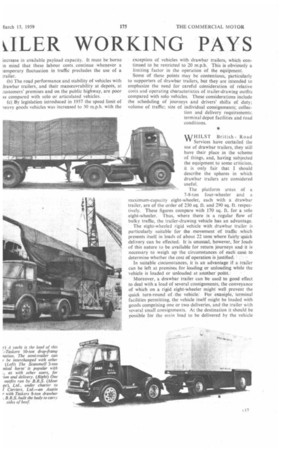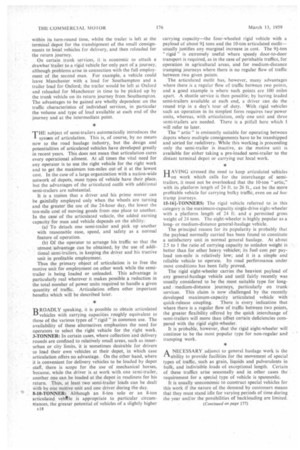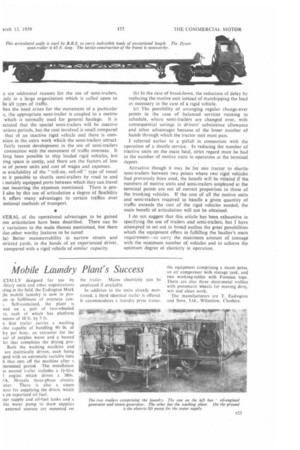WHERE dLER WORKING PAYS
Page 90

Page 91

Page 92

Page 97

If you've noticed an error in this article please click here to report it so we can fix it.
How to Derive the Greates from Drawbar Trailers a trailers: Merits of Three Pop' Pitfalls for the Uninit
IN setting out the pros and cons of trailers and semitrailers, as most operators and we in British Road Services have found them, it is only fair to say that the justification for the employment of drawbar trailers has always been a matter for close consideration on grounds of economy, and amendments to statutory regulations in recent years have not simplified the question.
In their heyday drawbar trailers were sometimes worked with maximum-capacity rigid eight-wheelers, but more commonly in combination with 7f-ton four-wheelers, and in special circumstances with ballasted tractor units. The present-day pattern is probably much the same, but the scale of operation has decreased. The use of a trailer for increasing the payload drawn by one power unit was—and in lesser degree remains—attractive, but over the years the advantage has tended to he off-set by higher costs, legislation and a greater appreciation of the benefits obtainable from the use of articulated vehicles.
Main disadvantages of drawbar trailer operation are: (a) Wages and subsistence costs are high because of the legal requirement for an attendant in addition to the driver. With the passage of time these costs have risen disproportionately to the benefit obtained by some
increase in available payload capacity. It must be borne Ln mind that these labour costs. continue, whenever a• Lemporary fluctuation in traffic precludes the use of a [railer.
(b) The road performance and stability of vehicles with Jrawbar trailers, and their manceuvrability at depots, at raistomers' premises and on the public highway, are poor as compared with solo or articulated vehicles.
(c) By legislation introduced in 1957 the speed limit of heavy goods vehicles was increased to 30 m.p.h. with the
exception of vehicles with drawbar trailers; which continued to be restricted to 20 m.p.h. This is obviously a limiting factor in the operatiOn of the eqttiPment.
Some of these points may be contentious, partictilarly to supporters of drawbar trailers, but they are intended to emphasize the need for careful consideration of relative costs and operating characteristics of trailer-drawing outfits compared with solo vehicles. These considerations include the scheduling of journeys and drivers' shifts. of 'duty; volume of traffic; size of individual consignments; collection and delivery requirements; terminal depot faciiities.and road condi lions.
‘XTHILST British, Road " Services have curtailed the use of drawbar trailers, they still have their place in the scheme of things, and, having subjected the equipment to some criticism, it is only fair that I should describe the spheres in which drawbar trailers are considered useful.
The platform areas of a 7-8-ton four-wheeler and a maximum-capacity eight-wheeler, each with a drawbar trailer, are of the order of 230 sq. ft. and 290 sq. ft. respectively. These figures compare with 170 sq. ft. for a solo eight-wheeler. Thus, where there is a regular flow of bulky traffic, the trailer-drawing vehicle has an advantage.
The eight-wheeled rigid vehicle with drawbar trailer is particularly suitable for the .movement of traffic which presents itself in loads of about 22 ton, where fairly-quick delivery can be effected. It is unusual, however, "for loads of this nature to be available for return journeys and it is necessary to weigh up the circumstances of each:case to determine whether the cost of operation is justified.
In suitable cinignstances, it is an advantage if a trailer can be left at premises for loading or unloading while the
vehicle is loaded or unfoaded at another. '
Moreover, a drawbar trailer can be used to good effect to deal with a load of several consignments, the conveyance of which on a rigid eight-wheeler might well prevent the quick turn-round of .the vehicle: For 'exarnple, terminal facilities permitting, the vehicle itself might be loaded with goods comprising one or two deliveries, and the trailer with several small consignments. At the destination it should be Possible for the main load to be delivered by the vehicle within its turn-round time, whilst the trailer is left at the terminal depot for the transhipment of the small consignments to local vehicles for delivery, and then reloaded for the return journey.
On certain trunk services, it is economic to attach a drawbar trailer to a rigid vehicle for only part of a journey, although problems arise in connection with the full employment of the second man. For example, a vehicle could leave Manchester with a load for Southampton and a trailer load for Oxford; the trailer would be left at Oxford and reloaded for Manchester in time to be picked up by the trunk vehicle on its return journey from Southampton. The advantages to be gained are wholly dependent on the traffic characteristics of individual services, in particular the volume and type of load available at each end of the journey and at the intermediate point.
THE subject of semi-trailers automatically introduces the 1 system of articulation. This is, of course, by no means new to the road haulage industry, but the design and potentialities of articulated vehicles have developed greatly in recent years. This does not mean that articulation cures every operational ailment. At all times the vital need for any operator is to use the right vehicle for the right work and to get the maximum ton-miles out of it at the lowest cost. In the case of a large organization with a nation-wide network of depots, most types of vehicle have their place, but the advantages of the articulated outfit with additional semi-trailers are substantial.
It is a truism that a driver and his prime mover can be gainfully employed only when the wheels are turning and the greater the use of the 24-hour day, the lower the ton-mile cost of moving goods from one place to another. In the case of the articulated vehicle, the added earning capacity for man and vehicle depends on the ability:
(a) To detach one semi-trailer and pick up another with reasonable ease, speed, and safety as a normal feature of operation.
(b) Of the operator to arrange his traffic so that the utmost advantage can be obtained, by the use of additional semi-trailers, in keeping the driver and his tractive unit in profitable employment.
Thus the primary object of articulation is to free the motive unit for employment on other work while the semitrailer is being loaded or unloaded. This advantage is particularly real wherever it makes possible a reduction in the total number of power units required to handle a given quantity of traffic. Articulation offers other important benefits which will be described later.
BROADLY speaking, it is possible to obtain articulated vehicles with carrying capacities roughly equivalent to those of the various types of " rigid " in common use. The availability of these alternatives emphasizes the need for operators to select the right vehicle for the, right work. 3-TONNER: In certain cases, where collection and delivery rounds are confined to relatively small areas, such as innerurban or city limits, it is sometimes desirable for drivers to load their own vehicles at their depot, in which ease articulation offers no advantage. On the other hand, where it is convenient for delivery vehicles to be loaded by depot staff, there is scope for the use of mechanical horses, because, while the driver is at work with one semi-trailer, another one can be loaded at the depot in readiness for his return. Thus, at least two semi-trailer loads can be dealt with by one motive unit and one driver during the day.
8-10-TONNER: Although an 8-ton solo or an 8-ton articulated vehl6le is appropriate to particular circumstances, the greater potential of vehicles of a slightly higher E t 8
carrying capacity—the four-wheeled rigid vehicle with a payload of about 9+ tons and the 10-ton articulated outfit— usually justifies any marginal increase in cost. The 9+-ton " rigid " is extremely useful where speedy door-to-door transport is required, as in the case of perishable traffics, for operation in agricultural areas, and for medium-distance tramping journeys where there is no regular flow of traffic between two given points.
The articulated outfit has, however, many advantages where there is a regular flow of traffic between two points, and a good example is where such points are 100 miles apart. A shuttle service is then possible; by having loaded semi-trailers available at each end, a driver can, do the round trip in a day's tour of duty. With rigid vehicles such an operation in its simplest form requires two'power units, whereas, with articulation, only one unit and three semi-trailers are needed, There is a pitfall here which t will refer to later.
The " artic " is eminently suitable for operating between depots where multiple consignments have to be transhipped and sorted for redelivery. While this working is proceeding only the semi-trailer is inactive, as the motive unit is available for either taking a pre-loaded semi-trailer to the distant terminal depot or carrying out local work.
[.1 AVING stressed the need to keep articulated whicles on work which calls for the interchange of semitrailers, it must not be overlooked that the 10-ton "attic," with its platform length of 24 ft. to 26 ft., can be the more profitable vehicle for carrying bulky traffic, even on ad hoc tramp journeys.
15-161-TONNERS: The rigid vehicle referred to in this category is the maximum-capacity single-drive eight-wheeler with a platform length of 24 ft. and a' permitted gross weight of 24 tons_ The eight-wheeler is highly popular as a longor medium-distance general-haulage vehicle.
The principal reason for its popularity is probably that the payload normally carried has been found to constitute a satisfactory unit in normal general haulage. At about 2.5 to 1 the ratio of carrying capacity to unladen weight is better than for other heavy vehicles; its fuel cost per payload ton-mile is relatively low; and it is a simple and reliable vehicle to operate. Its road performance under most conditions has been fully proved.
The rigid eight-wheeler carries the heaviest payload of any general-haulage vehicle and until fairly recently was usually considered to be the most suitable type for longand medium-distance journeys, particularly on trunk services. This claim is now challenged by the recently developed maximum-capacity articulated vehicle with quick-release coupling. There is every indication that where there is a regular flow of traffic between two points, the greater flexibility offered by the quick interchange of semi-trailers will more than 'offset certain deficiencies compared with the rigid eight-wheeler.
It is probable, however, that the rigid eight-wheeler will continue to be the most popular type for non-regular and tramping work.
ANECESSARY adjunct to general haulage work is the ability to provide facilities for the movement of special types of traffic, such as grain, liquids and pulverulents in bulk, and indivisible loads of exceptional length. Certain of these traffics arise seasonally and in other cases the requirement for a special type of vehicle is spasmodic.
It is usually uneconomic to construct special vehicles for this work if the nature of the demand by customers means that they must stand idle for varying periods of time during the year and/or the possibilities of backloading are limited. e are additional reasons for the use of semi-trailers, .inly in a large organization which is called upon to Ile all types of traffic.
hen the need arises for the movement of a particular
c, the appropriate semi-trailer is coupled to a motive which is normally used for general haulage. It is eciated that the special semi-trailers will be inactive 'arious periods, but.the cost involved is small compared that of an inactive rigid vehicle and there is cornalien in the extra work which the semi-trailers attract. fairly recent development in the use of semi-trailers connection with the movement of traffic overseas. It long been possible to ship loaded rigid vehicles, but 3ing space is costly, and there are the factors of loss se of power units and cost of wages and expenses.
se availability of the "roll-on, roll-off " type of vessel es it possible to shuttle semi-trailers by road to and suitably equipped ports between which they can travel out incurring the expenses mentioned. There is proalso by this use of articulation a degree of flexibility Ii offers many advantages to certain traffics over 'entional methods of transport.
VERAL of the operational advantages to be gained om articulation have been described. There can be y variations to the main themes mentioned, but there dso other worthy features to be noted: (a) Better manceuvrability in narrow streets and stricted yards, in the hands of an experienced driver, compared with a rigid vehicle of similar capacity. (b) In the case of breakdown, the reduction of delay by replacing the motive unit instead of transhipping the load as necessary in the case of a rigid vehicle.
(c) The possibility of arranging regular change-over points in the case of balanced services running to schedule, where semi-trailers are changed over, with consequential savings in drivers' subsistence allowance and other advantages because of the lesser number of hands through which the tractor unit must pass.
I referred earlier to a pitfall in connection with the operation of a shuttle service. In reducing the number of -tractive units on the main haul, strict regard must be had to the number of motive units in operation at the terminal depots.
Attractive though it may be for one tractor to shuttle semi-trailers between two points where two rigid vehicles had previously been used, the benefit will be vitiated if the, numbers of motive units and semi-trailers employed at the terminal points are out of correct proportion to those of the trunking vehicles. if the cost of all the motive units and semi-trailers required to handle a given quantity of traffic exceeds the cost of the rigid vehicles needed, the main benefit of articulation will not be obtained.
I do not suggest that this article has been exhaustive in specifying the use of trailers and semi-trailers, but I have attempted to set out in broad outline the great possibilities which the equipment offers in fulfilling the hauliers main requirement—to carry the maximum amount of tonnage with the minimum number of vehicles and to achieve the optimum degree of elasticity in operation.




















































































































































































